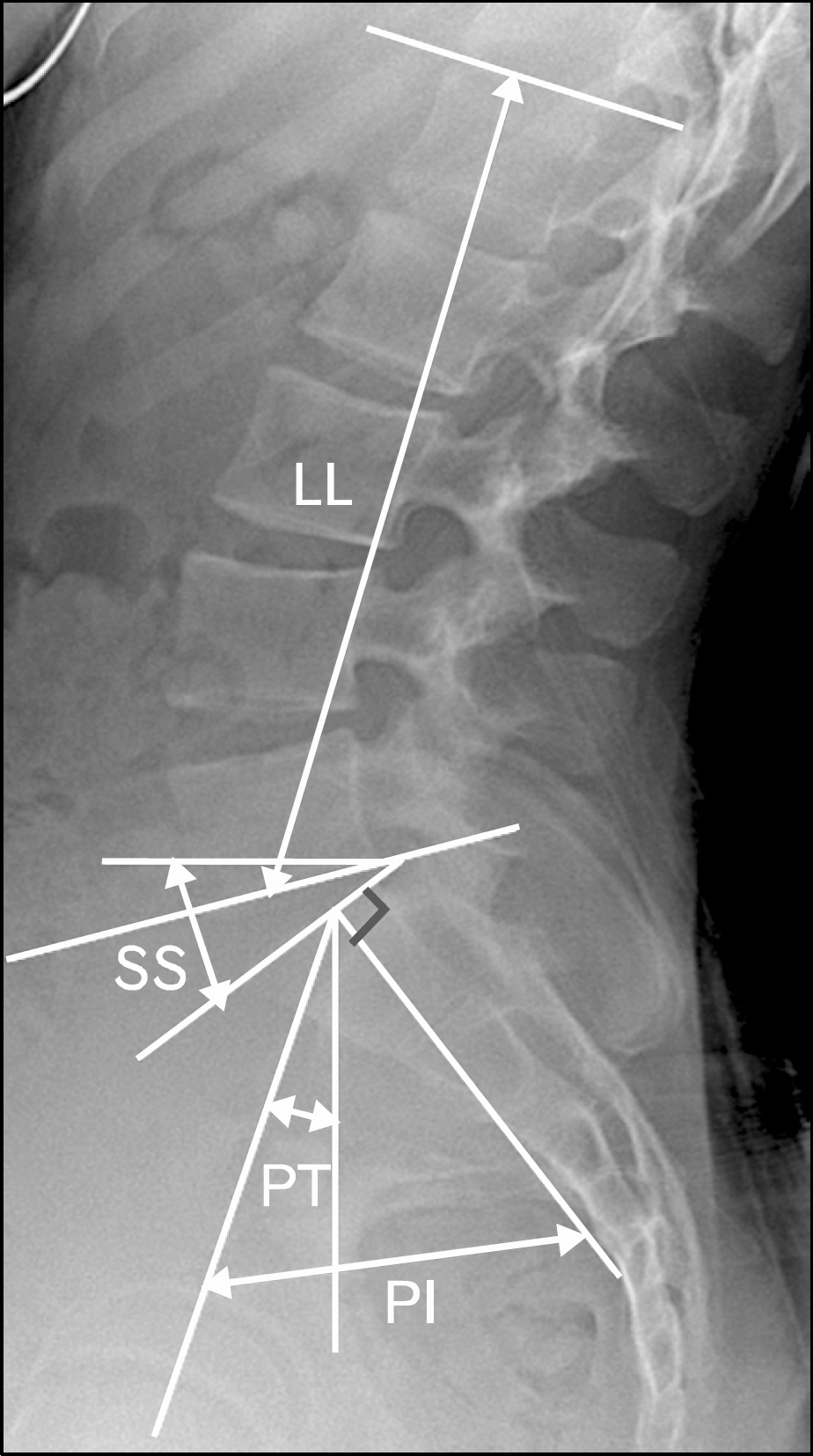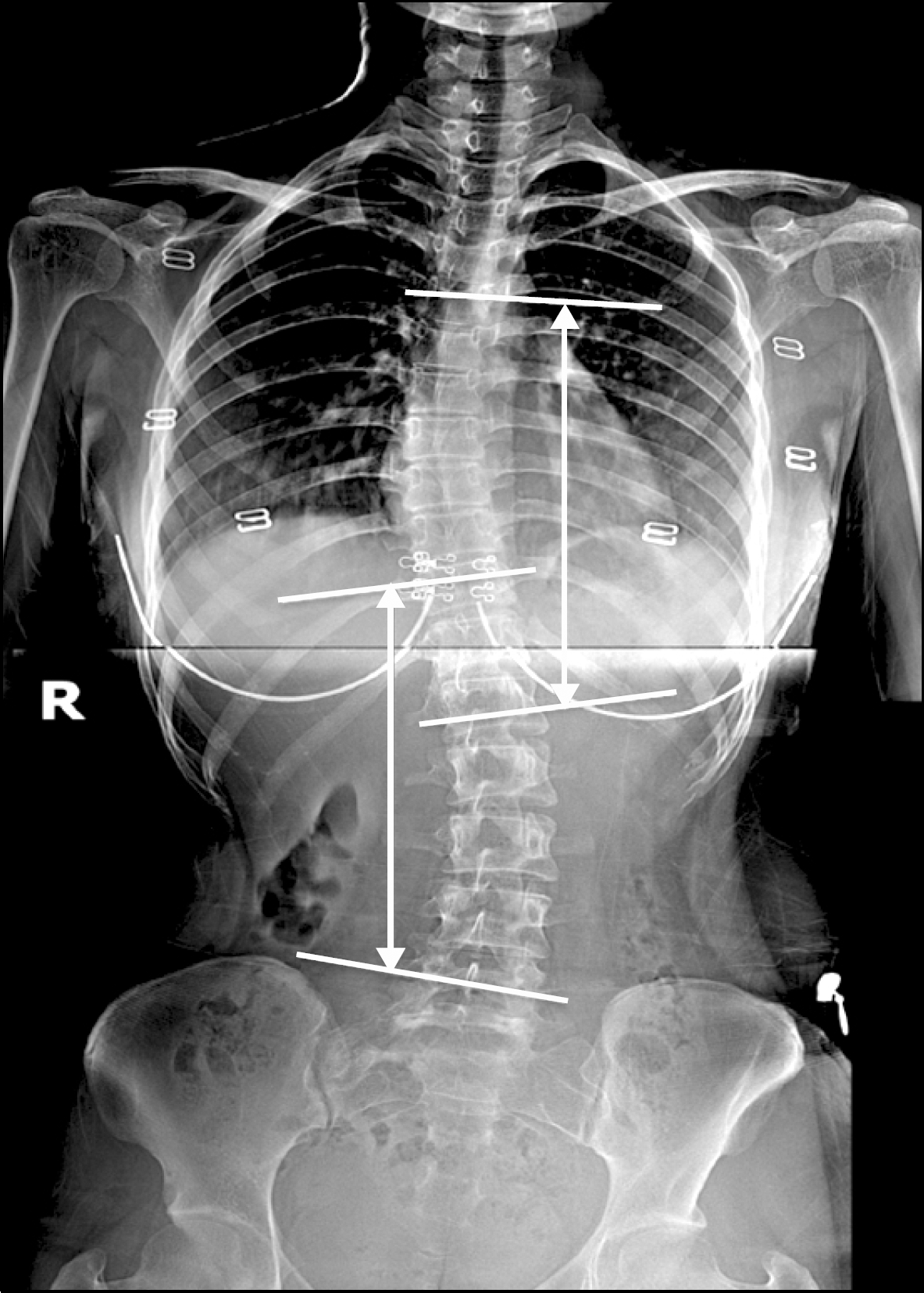Abstract
The purpose of this study was to evaluate the prevalence rate of low back pain (LBP) in the high school students and to analyze the differences and correlations with the spinal-pelvic structural variations and disability index with LBP. The subjects are 499 high school students (236 males, 263 females: mean age, 16.38 years). They were assessed for LBP with the numerical rating scale (NRS) and for disability with the Korean version Oswestry disability index (KODI). All subjects were to take the plain radiographic examination for spinal-pelvic structural variations including thoracic, lumbar, thoracolumbar Cobb's angle, lumbar lordotic curve, sacral slope, pelvic tilt and pelvic incidence. All subjects were divided into two groups by NRS scores (0, 1=no/minimum pain group [NMP group], 2−10=low back pain group [LBP group]). The prevalence rate of LBP of all subjects was 56.7% (n=283). NRS and total KODI scores were higher in the LBP group (3.38 cm/11.83%) than NMP group (0.07 cm/2.74%) (p<0.001). In the spinal-pelvic structural variations analysis, the thoracic Cobb's angle was significantly high in LBP group (p <0.05), but others were shown no differences between the both groups (p>0.05). NRS had significantly positive correlation with KODI (p<0.001). NRS and KODI did not demonstrate any correlations with spinal-pelvic structural variations (p>0.05). In conclusion, this study showed high prevalence rate of LBP in the high school students, but did not show significant correlations with the spinal-pelvic structural variations and disability index.
REFERENCES
1. Nourbakhsh MR, Arab AM. Relationship between mechanical factors and incidence of low back pain. J Orthop Sports Phys Ther. 2002; 32:447–60.

2. Manek NJ, MacGregor AJ. Epidemiology of back disorders: prevalence, risk factors, and prognosis. Curr Opin Rheumatol. 2005; 17:134–40.

3. Lee SH. Yearbook of school health. 35th ed.Seoul: Seoul School Health Center;2005.
4. Suh SW, Modi HN, Yang JH, Hong JY. Idiopathic scoliosis in Korean schoolchildren: a prospective screening study of over 1 million children. Eur Spine J. 2011; 20:1087–94.
5. Christie HJ, Kumar S, Warren SA. Postural aberrations in low back pain. Arch Phys Med Rehabil. 1995; 76:218–24.

7. Jackson RP, Simmons EH, Stripinis D. Incidence and severity of back pain in adult idiopathic scoliosis. Spine (Phila Pa 1976). 1983; 8:749–56.

8. Trammell TR, Schroeder RD, Reed DB. Rotatory olisthesis in idiopathic scoliosis. Spine (Phila Pa 1976). 1988; 13:1378–82.

9. Evcik D, Yucel A. Lumbar lordosis in acute and chronic low back pain patients. Rheumatol Int. 2003; 23:163–5.

10. Na YM, Kang SW, Bae HS, Kang MJ, Park JS, Moon JH. The analysis of spinal curvature in low back pain patients. J Korean Acad Rehabil Med. 1996; 20:669–74.
12. Fairbank JC, Couper J, Davies JB, O'Brien JP. The Oswestry low back pain disability questionnaire. Physiotherapy. 1980; 66:271–3.
13. Kim GM, Park SY, Lee CH. A Rasch analysis of the Korean version of Oswestry Disability Questionnaire according to general characteristics of patients with low back pain. J Korean Acad Univ Trained Phys Therapists. 2011; 18:35–42.
14. Handrakis JP, Friel K, Hoeffner F, et al. Key characteristics of low back pain and disability in college-aged adults: a pilot study. Arch Phys Med Rehabil. 2012; 93:1217–24.

15. Kim DY, Lee SH, Lee HY, et al. Validation of the Korean version of the oswestry disability index. Spine (Phila Pa 1976). 2005; 30:E123–7.

16. Cobb JR. Outline for the study of scoliosis. Instr Course Lect. 1948; 5:261–75.
17. Legaye J, Duval-Beaupere G, Hecquet J, Marty C. Pelvic incidence: a fundamental pelvic parameter for three-dimensional regulation of spinal sagittal curves. Eur Spine J. 1998; 7:99–103.

18. Bae JS, Jang JS, Lee SH, Kim JU. Radiological analysis of lumbar degenerative kyphosis in relation to pelvic incidence. Spine J. 2012; 12:1045–51.

19. Lee CI, Park CG. The effect of cobb's angle and body composition in functional scoliosis on progressive elastic resistance training. J Sport Leis Stud. 2009; 2009:889–97.

20. Jones GT, Silman AJ, Macfarlane GJ. Parental pain is not associated with pain in the child: a population based study. Ann Rheum Dis. 2004; 63:1152–4.

21. Kouwenhoven JW, Castelein RM. The pathogenesis of adolescent idiopathic scoliosis: review of the literature. Spine (Phila Pa 1976). 2008; 33:2898–908.
22. Gunnoe BA. Adolescent idiopathic scoliosis. Orthop Rev. 1990; 19:35–43.
23. Lee MS. Effects of an exercise program including promotion of self-efficacy on the physical and psychological functions of middle school students with minimal scoliosis. J Korean Acad Soc Nurs Educ. 2008; 14:282–93.

24. Jang MJ, Cho HJ. The effect of performing a 12 weeks` exercise program on the change of Cobb`s angle of disabled adolescents with idiopathic scoliosis. J Adapt Phys Act Exerc. 2010; 18:117–27.
25. Jackson RP, McManus AC. Radiographic analysis of sagittal plane alignment and balance in standing volunteers and patients with low back pain matched for age, sex, and size. A prospective controlled clinical study. Spine (Phila Pa 1976). 1994; 19:1611–8.
26. Hansson T, Bigos S, Beecher P, Wortley M. The lumbar lordosis in acute and chronic low-back pain. Spine (Phila Pa 1976). 1985; 10:154–5.

27. Lazennec JY, Ramare S, Arafati N, et al. Sagittal alignment in lumbosacral fusion: relations between radiological parameters and pain. Eur Spine J. 2000; 9:47–55.

28. Mac-Thiong JM, Berthonnaud E, Dimar JR 2nd, Betz RR, Labelle H. Sagittal alignment of the spine and pelvis during growth. Spine (Phila Pa 1976). 2004; 29:1642–7.

29. Kong JC, Moon SJ, Jo DC, Ko YS, Song YS, Lee JH. Study on pelvic parameters and biomechanical characteristics of foot in patients with chronic low back pain. Korean J Orient Med Physiol Pathol. 2012; 26:81–7.
30. Cho YJ, Chung SH, Song MY. Relationship between leg length discrepancy and radiological parameters of lumbo-sacrum and pelvis in patients with chronic low back pain. J Orient Rehabil Med. 2010; 20:171–83.
Fig. 3.
Measurement of the lumbar and pelvic parameters used in the current study. Lumbar lordotic curve (LL), sacral slope (SS), pelvic tilt (PT), and pelvic incidence (PI) were measured in each whole spine lateral view.

Table 1.
General characteristics of all subjects
Table 2.
Comparison of general characteristics, NRS and KODI score between two groups (NMP, LBP)
Table 3.
Comparison of spine and pelvic angle parameters between two groups (NMP, LBP)
Table 4.
Correlations coefficients between variables for all subjects with NRS>0 (n=499)
| Variables | NRS | KODI | ThCb | LbCb | TlCb | LoCv | SacSl | PvTi | PvIn | |
|---|---|---|---|---|---|---|---|---|---|---|
| NRS | r | 1.00 | ||||||||
| KODI | r | 0.816∗ | 1.00 | |||||||
| ThCb | r | 0.054 | 0.054 | 1.00 | ||||||
| LbCb | r | 0.000 | 0.002 | 0.737∗ | 1.00 | |||||
| TlCb | r | -0.028 | -0.029 | -0.399∗ | -0.437∗ | |||||
| LoCv | r | -0.029 | -0.016 | -0.021 | 0.116† | -0.041 | 1.00 | |||
| SacSl PvTi | r r | -0.020 -0.050 | -0.018 0.027 | -0.029 -0.028 | 0.039 0.019 | -0.003 -0.001 | 0.679∗ 0.063 | 1.00 -0.118† | 1.00 | |
| PvIn | r | -0.062 | -0.025 | -0.035 | 0.034 | -0.004 | 0.506∗ | 0.660∗ | 0.559∗ | 1.00 |
Tested by partial correlation analysis adjusted age. NRS: numerical rating scale, KODI: korean version of oswestry disability index, ThCb: thoracic Cobb's angle, LbCb: lumbar Cobb's angle, TlCb: thoracolumbar Cobb's angle, LoCv: lumbar lordtic curve, SacSl: sacral slope, PvTi: pelvic tilt, PvIn: pelvic incidence.∗Statistically significant at p<0.001;




 PDF
PDF ePub
ePub Citation
Citation Print
Print




 XML Download
XML Download